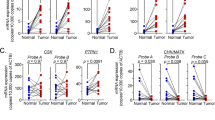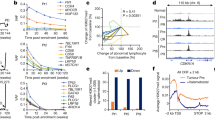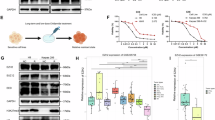Abstract
The tumor suppressor Chk2 kinase plays crucial roles in regulating cell-cycle checkpoints and apoptosis following DNA damage. We investigated the expression levels of the genes encoding Chk2 and several cell-cycle regulators in nine cell lines from lymphoid malignancies, including three Hodgkin's lymphoma (HL) lines. We found that all HL cell lines exhibited a drastic reduction in Chk2 expression without any apparent mutation of the Chk2 gene. However, expression of Chk2 in HL cells was restored following treatment with the histone deacetylase inhibitors trichostatin A (TsA) and sodium butyrate (SB), or with the DNA methyltransferase inhibitor 5-aza-2′-deoxycytidine (5Aza-dC). Chromatin-immunoprecipitation (Chip) assays revealed that treatment of HL cells with TsA, SB or 5Aza-dC resulted in increased levels of acetylated histones H3 and H4, and decreased levels of dimethylated H3 lysine 9 at the Chk2 promoter. These results indicate that expression of the Chk2 gene is downregulated in HL cells via epigenetic mechanisms.
Similar content being viewed by others
Log in or create a free account to read this content
Gain free access to this article, as well as selected content from this journal and more on nature.com
or
Abbreviations
- ATM:
-
ataxia-telangiectasia-mutated
- 5Az-dC:
-
5-aza-2′-deoxycytidine
- Chip:
-
chromatin-immunoprecipitation
- CKI:
-
cyclin-dependent protein kinase inhibitor
- FCS:
-
fetal calf serum
- HDAC:
-
histone deacetylase
- HL:
-
Hodgkin's lymphoma
- H/RS:
-
Hodgkin and Reed-Sternberg
- IR:
-
ionizing radiation
- LFS:
-
Li-Fraumeni syndrome
- MSP:
-
methylation-specific PCR
- PMSF:
-
phenylmethyl sulfonyl fluoride
- SB:
-
sodium butyrate
- TsA:
-
trichostatin A
References
Matsuoka S, Huang M and Elledge SJ (1998) Linkage of ATM to cell cycle regulation by the Chk2 protein kinase. Science 282: 1893–1897
Bartek J, Falck J and Lukas J (2001) Chk2 kinase – a busy messenger. Nat. Rev. Mol. Cell. Biol. 2: 877–886
Bartek J and Lukas J (2003) Chk1 and Chk2 kinases in checkpoint control and cancer. Cancer Cell 3: 421–429
Brown AL, Lee C-H, Schwarz JK, Mitiku N, Piwnica-Worms H and Chung JH (1999) A human Cds1-related kinase that functions downstream of ATM protein in the cellular response to DNA damage. Proc. Natl. Acad. Sci. USA 96: 3745–3750
Chaturvedi P, Eng WK, Zhu Y, Mattern MR, Mishra R, Hurle MR, Zhang X, Annan RS, Lu Q, Faucette LF, Scott GF, Li X, Carr SA, Johnson RK, Winkler JD and Zhou BB (1999) Mammalian Chk2 is a downstream effector of the ATM-dependent DNA damage checkpoint pathway. Oncogene 18: 4047–4054
Melchionna R, Chen X-B, Blasina A and McGowan CH (2000) Threonine 68 is required for radiation-induced phosphorylation and activation of Cds1. Nat. Cell Biol. 2: 762–765
Matsuoka S, Rotman G, Ogawa A, Shiloh Y, Tamai K and Elledge SJ (2000) Ataxia telangiectasia-mutated phosphorylates Chk2 in vivo and in vitro. Proc. Natl. Acad. Sci. USA 97: 10389–10394
Ahn J-Y, Schwarz JK, Piwnica-Worms H and Canman CE (2000) Threonine 68 phosphorylation by ataxia telangiectasia mutated is required for efficient activation of Chk2 in response to ionizing radiation. Cancer Res. 60: 5934–5936
Blasina A, de Weyer IV, Laus MC, Luyten WH, Parker AE and McGowan CH (1999) A human homologue of the checkpoint kinase Cds1 directly inhibits Cdc25 phosphatase. Curr. Biol. 9: 1–10
Chehab NH, Malikzay A, Appel M and Halazonetis TD (2000) Chk2/hCds1 functions as a DNA damage checkpoint in G1 by stabilizing p53. Genes Dev. 14: 278–288
Shieh SY, Ahn J, Tamai K, Taya Y and Prives C (2000) The human homologs of checkpoint kinases Chk1 and Cds1 (Chk2) phosphorylate p53 at multiple DNA damage-inducible sites. Genes Dev. 14: 289–300
Lee JS, Collins KM, Brown AL, Lee CH and Chung JH (2000) hCds1-mediated phosphorylation of BRCA1 regulates the DNA damage response. Nature 404: 201–204
Yang S, Kuo C, Bisi JE and Kim MK (2002) PML-dependent apoptosis after DNA damage is regulated by the checkpoint kinase hCds1/Chk2. Nat. Cell Biol. 4: 865–870
Stevens C, Smith L and La Thangue NB (2003) Chk2 activates E2F-1 in response to DNA damage. Nat. Cell. Biol. 5: 401–409
Bell DW, Varley JM, Szydlo TE, Kang DH, Wahrer DC, Shannon KE, Lubratovich M, Verselis SJ, Isselbacher KJ, Fraumeni JF, Birch JM, Li FP, Garber JE and Haber DA (1999) Heterozygous germ line hChk2 mutations in Li-Fraumeni syndrome. Science 286: 2528–2531
Vahteristo P, Tamminen A, Karvinen P, Eerola H, Eklund C, Aaltonen LA, Blomqvist C, Aittomaki K and Nevanlinna H (2001) p53, Chk2, and Chk1 genes in Finnish families with Li-Fraumeni syndrome: further evidence of Chk2 in inherited cancer predisposition. Cancer Res. 61: 5718–5722
Lee SB, Kim SH, Bell DW, Wahrer DC, Schiripo TA, Jorczak MM, Sgroi DC, Garber JE, Li FP, Nichols KE, Varley JM, Godwin AK, Shannon KM, Harlow E and Haber DA (2001) Destabilization of CHK2 by a missense mutation associated with Li-Fraumeni syndrome. Cancer Res. 61: 8062–8067
Haruki N, Saito H, Tatematsu Y, Konishi H, Harano T, Masuda A, Osada H, Fujii Y and Takahashi T (2000) Histological type-selective, tumor-predominant expression of a novel CHK1 isoform and infrequent in vivo somatic CHK2 mutation in small cell lung cancer. Cancer Res. 60: 4689–4692
Bartkova J, Falck J, Rajpert-De Meyts E, Skakkebak NE, Lukas J and Bartek J (2001) Chk2 tumour suppressor protein in human spermatogenesis and testicular germ-cell tumours. Oncogene 20: 5897–5902
Matsuoka S, Nakagawa T, Masuda A, Haruki N, Elledge SJ and Takahashi T (2001) Reduced expression and impaired kinase activity of a Chk2 mutant identified in human lung cancer. Cancer Res. 61: 5362–5365
Miller CW, Ikezoe T, Krug U, Hofmann WK, Tavor S, Vegesna V, Tsukasaki K, Takeuchi S and Koeffler HP (2002) Mutations of the CHK2 gene are found in some osteosarcomas, but are rare in breast, lung, and ovarian tumors. Genes Chromosomes Cancer 33: 17–21
Reddy A, Yuille M, Sullivan A, Repellin C, Bell A, Tidy JA, Evans DJ, Farrell PJ, Gusterson B, Gasco M and Crook T (2002) Analysis of CHK2 in vulval neoplasia. Br. J. Cancer 86: 756–760
Hofmann WK, Miller CW, Tsukasaki K, Tavor S, Ikezoe T, Hoelzer D, Takeuchi S and Koeffler HP (2001) Mutation analysis of the DNA-damage checkpoint gene Chk2 in myelodysplastic syndromes and acute myeloid leukemias. Leuk. Res. 25: 333–338
Tavor S, Takeuchi S, Tsukasaki K, Miller CW, Hofmann WK, Ikezoe T, Said JW and Koeffler HP (2001) Analysis of the CHK2 gene in lymphoid malignancies. Leuk. Lymphoma 42: 517–520
Hangaishi A, Ogawa S, Qiao Y, Wang L, Hosoya N, Yuji K, Imai Y, Takeuchi K, Miyawaki S and Hirai H (2002) Mutations of Chk2 in primary hematopoietic neoplasms. Blood. 99: 3075–3077
Imamura J, Miyoshi I and Koeffler HP (1994) p53 in hematologic malignancies. Blood 84: 2412–2421
Hernandez L, Fest T, Cazorla M, Teruya-Feldstein J, Bosch F, Peinado MA, Piris MA, Montserrat E, Cardesa A, Jaffe ES, Campo E and Raffold M (1996) p53 gene mutations and protein overexpression are associated with aggressive variants of mantle cell lymphomas. Blood 87: 3351–3359
Morrell D, Cromartie E and Swift M (1986) Mortality and cancer incidence in 263 patients with ataxia telangiectasia. J. Natl. Cancer Inst. 77: 89–92
Camacho E, Hernandez L, Hernandez S, Tort F, Bellosillo B, Bea S, Bosch F, Montserrat E, Cardesa A, Fernandez PL and Campo E (2002) ATM gene inactivation in mantle cell lymphoma mainly occur by truncating mutations and missense mutations involving the phosphatidylinositol-3 kinase domain and is associated with increasing numbers of chromosomal imbalances. Blood 99: 238–244
Stankovic T, Stewart GS, Fegan C, Biggs P, Last J, Byrd PJ, Keenan RD, Moss PA and Taylor AM (2002) Ataxia telangiectasia mutated-deficient B-cell chronic lymphocytic leukemia occurs in pregerminal center cells and results in defective damage response and unrepaired chromosome damage. Blood 99: 300–309
Wu X, Webster SR and Chen J (2001) Characterization of tumor-associated Chk2 mutations. J. Biol. Chem. 276: 2971–2974
Tort F, Hernandez S, Bea S, Martinez A, Esteller M, Herman JG, Puig X, Camacho E, Sanchez M, Nayach I, Lopez-Guillermo A, Fernandez PL, Colomer D, Hernandez L and Campo E (2002) CHK2-decreased protein expression and infrequent genetic alterations mainly occur in aggressive types of non-Hodgkin lymphomas. Blood 100: 4602–4608
Garcia JF, Villuendas R, Sanchez-Beato M, Sanchez-Aguilera A, Sanchez L, Prieto I and Piris MA (2002) Nucleolar p14 (ARF) overexpression in Reed-Sternberg cells in Hodgkin's lymphoma: absence of p14 (ARF)/Hdm2 complexes is associated with expression of alternatively spliced Hdm2 transcripts. Am. J. Pathol. 160: 569–578
Garcia JF, Villuendas R, Algara P, Saez AI, Sanchez-Verde L, Martinez-Montero JC, Martinez P and Piris MA (1999) Loss of p16 protein expression associated with methylation of the p16INK4A gene is a frequent finding in Hodgkin's disease. Lab. Invest. 79: 1453–1459
Jungnickel B, Staratschek-Jox A, Brauninger A, Spieker T, Wolf J, Diehl V, Hansmann ML, Rajewsky K and Kuppers R (2000) Clonal deleterious mutations in the IkappaBalpha gene in the malignant cells in Hodgkin's lymphoma. J. Exp. Med. 191: 395–402
Garcia JF, Camacho FI, Morente M, Fraga M, Montalban C, Alvaro T, Bellas C, Castano A, Diez A, Flores T, Martin C, Martinez MA, Mazorra F, Menarguez J, Mestre MJ, Mollejo M, Saez AI, Sanchez L, Piris MA and Spanish Hodgkin Lymphoma Study Group (2003) Hodgkin and Reed-Sternberg cells harbor alterations in the major tumor suppressor pathways and cell-cycle checkpoints: analyses using tissue microarrays. Blood 101: 681–689
Maggio EM, Stekelenburg E, Van den Berg A and Poppema S (2001) TP53 gene mutations in Hodgkin lymphoma are infrequent and not associated with absence of Epstein–Barr virus. Int. J. Cancer 94: 60–66
Nakayama J-I, Rice JC, Strahl BD, Allis CD and Grewal SIS (2001) Role of histone H3 lysine 9 methylation in epigenetic control of heterochromatin assembly. Science 292: 110–113
Turner BM (2002) Cellular memory and the histone code. Cell 111: 285–291
Iizuka M and Smith MM (2003) Functional consequences of histone modifications. Curr. Opin. Genet. Dev. 13: 154–160
Fischle W, Wang Y and Allis CD (2003) Histone and chromatin cross-talk. Curr. Opin. Cell Biol. 15: 172–183
Nguyen CT, Weisenberger DJ, Velicescu M, Gonzales FA, Lin JC, Liang G and Jones PA (2002) Histone H3-Lysine 9 methylation is associated with aberrant gene silencing in cancer cells and is rapidly reversed by 5-Aza-2′-deoxycytidine. Cancer Res. 62: 6456–6461
Nan X, Ng HH, Johnson CA, Laherty CD, Turner BM, Eisenman RN and Bird A (1998) Transcriptional repression by the methyl-CpG-binding protein MeCP2 involves a histone deacetylase complex. Nature 393: 386–389
Jones PL, Veenstra GJ, Wade PA, Vermaak D, Kass SU, Landsberger N, Strouboulis J and Wolffe AP (1998) Methylated DNA and MeCP2 recruit histone deacetylase to repress transcription. Nat. Genet. 19: 187–191
Hirao A, Cheung A, Duncan G, Girard PM, Elia AJ, Wakeham A, Okada H, Sarkissian T, Wong JA, Sakai T, De Stanchina E, Bristow RG, Suda T, Lowe SW, Jeggo PA, Elledge SJ and Mak TW (2002) Chk2 is a tumor suppressor that regulates apoptosis in both an ataxia telangiectasia mutated (ATM)-dependent and an ATM-independent manner. Mol. Cell. Biol. 22: 6521–6532
Takai H, Naka K, Okada Y, Watanabe M, Harada N, Saito S, Anderson CW, Appella E, Nakanishi M, Suzuki H, Nagashima K, Sawa H, Ikeda K and Motoyama N (2002) Chk2-deficient mice exhibit radioresistance and defective p53-mediated transcription. EMBO J. 21: 5195–5205
Fiscella M, Zhang H, Fan S, Sakaguchi K, Shen S, Mercer WE, Vande Woude GF, O'Connor PM and Appella E (1997) Wip1, a novel human protein phosphatase that is induced in response to ionizing radiation in a p53-dependent manner. Proc. Natl. Acad. Sci. USA 94: 6048–6053
Harper JW, Adami GR, Wei N, Keyomarsi K and Elledge SJ (1993) The p21 Cdk-interacting protein Cip1 is a potent inhibitor of cyclin-dependent kinases. Cell 19: 805–816
El-Deiry WS, Tokino T, Velculescu VE, Levy DB, Parsons R, Trent JM, Lin D, Mercer WE, Kinzler KW and Vogelstein B (1993) WAF1, a potential mediator of p53 tumor suppression. Cell 19: 817–825
Takekawa M, Adachi M, Nakahata A, Nakayama I, Itoh F, Tsukuda H, Taya Y and Imai K (2000) p53-inducible Wip1 phosphatase mediates a negative feedback regulation of p38 MAPK-p53 signaling in response to UV radiation. EMBO J. 19: 6517–6526
Yung L and Linch D (2003) Hodgkin's lymphoma. Lancet 361: 943–951
Hinz M, Löser P, Mathas S, Krappmann D, Dörken B and Scheidereit C (2001) Constitutive NF-κB maintains high expression of a characteristic gene network, including CD40, CD86, and a set of antiapoptotic genes in Hodgkin/Reed-Sternberg cells. Blood 97: 2798–2807
Mathas S, Hinz M, Anagnostopoulos I, Krappmann D, Lietz A, Jundt F, Bommert K, Mechta-Grigoriou F, Stein H, Dorken B and Scheidereit C (2002) Aberrantly expressed c-Jun and JunB are a hallmark of Hodgkin lymphoma cells, stimulate proliferation and synergize with NF-κB. EMBO J. 21: 4104–4113
Hinz M, Lemke P, Anagnostopoulos I, Hacker C, Krappmann D, Mathas S, Dorken B, Zenke M, Stein H and Scheidereit C (2002) Nuclear factor κB-dependent gene expression profiling of Hodgkin's disease tumor cells, pathogenetic significance, and link to constitutive signal transducer and activator of transcription 5a activity. J. Exp. Med. 196: 605–617
Takagi M, Tsuchida R, Oguchi K, Shigeta T, Nakada S, Shimizu K, Ohki M, Delia D, Chessa L, Taya Y, Nakanishi M, Tsunematsu Y, Bessho F, Isoyama K, Hayashi Y, Kudo K, Okamura J and Mizutani S (2004) Identification and characterization of polymorphic variations of the ataxia telangiectasia mutated (ATM) gene in childhood Hodgkin disease. Blood 103: 283–290
Bachman KE, Park BH, Rhee I, Rajagopalan H, Herman JG, Baylin SB, Kinzler KW and Vogelstein B (2003) Histone modifications and silencing prior to DNA methylation of a tumor suppressor gene. Cancer Cell 3: 89–95
Hsu SM, Zhao X, Chakraborty S, Liu YF, Whang-Peng J, Lok MS and Fukuhara S (1988) Reed-Sternberg cells in Hodgkin's cell Lines HDLM, L428, and KM-H2 are not actively replicating: lack of bromodeoxyuridine uptake by multinuclear cells in culture. Blood 71: 1382–1389
Nakamura M, Kudo T, Narimatsu H, Furukawa Y, Kikuchi J, Asakura S, Yang W, Iwase S, Hatake K and Miura Y (1998) Single glycosyltransferase, core 2β1 to 6-N-acetylglucosaminyltransferase, regulates cell surface Sialy-Lex expression level in human pre-B lymphocytic leukemia cell line KM3 treated with phorbolester. J. Biol. Chem. 273: 26779–26789
Beckwith M, Longo DL, O'Connell CD, Moratz CM and Urba WJ (1990) Phorbol ester-induced, cell-cycle-specific, growth inhibition of human B-lymphoma cell lines. J.Natl. Cancer Inst. 82: 501–509
Amakawa R, Fukuhara S, Ohno H, Tanabe S, Horii M, Matsuyama F, Kato I, Kakita T and Nagauchi O (1990) Amplified and rearranged bcl-2 gene in two lymphoma cell lines, FL-218 and FL-318, carrying a 14;18 translocation. Cancer Res. 50: 2423–2428
Tani A, Tatsumi E, Nakamura F, Kumagai S, Kosaka Y, Sano K, Nakamura H, Amakawa R and Ohno H (1996) Sensitivity to dexamethasone and absence of bcl-2 protein in Burkitt's lymphoma cell line (Black 93) derived from a patient with acute tumor lysis syndrome: comparative study with other BL and non-BL lines. Leukemia 10: 1592–1603
Weiss A, Wiskocil RL and Stobo JD (1984) The role of T3 surface molecules in the activation of human T cells: a two-stimulus requirement for IL 2 production reflects events occurring at a pre-translational level. J. Immunol. 133: 123–128
Oishi I, Iwai K, Kagohashi Y, Fujimoto H, Kariya K, Kataoka T, Sawa H, Okano H, Otani H, Yamamura H and Minami Y (2001) Critical role of Caenorhabditis elegans homologs of Cds1 (Chk2)-related kinases in meiotic recombination. Mol. Cell. Biol. 21: 1329–1335
Baker SJ, Markowitz S, Fearon ER, Willson JK and Vogelstein B (1990) Suppression of human colorectal carcinoma cell growth by wild-type p53. Science 249: 912–915
Roman-Gomez J, Castillejo JA, Jimenez A, Gonzalez MG, Moreno F, Rodriguez Mdel C, Barrios M, Maldonado J and Torres A (2002) 5′CpG island hypermethylation is associated with transcriptional silencing of the p21CIP1/WAF1/SDI1gene and confers poor prognosis in acute lymphoblastic leukemia. Blood 99: 2291–2296
Kawano S, Miller CW, Gombart AF, Bartram CR, Matsuo Y, Asou H, Sakashita A, Said J, Tatsumi E and Koeffler HP (1999) Loss of p73 gene expression in leukemias/lymphomas due to hypermethylation. Blood 94: 1113–1120
Herman JG, Graff JR, Myohanen S, Nelkin BD and Baylin SB (1996) Methylation-specific PCR: a novel assay for methylation status of CpG islands. Proc. Natl. Acad. Sci. USA 93: 9821–9826
Ghoshal K, Datta J, Majumder S, Bai S, Dong X, Parthun M and Jacob ST (2002) Inhibitors of histone deacethylase and DNA methyltransferase synergistically active the methylated metallothionein I promoter by activating the transcription factor MTF-1 and forming an open chromatin structure. Mol. Cell. Biol. 22: 8302–8319
Acknowledgements
We thank Drs. M Lamphier and A Noda for critical reading of the manuscript, E Tatsumi for providing HDLM2, KM-H2, L428, KM3, RL, FL318, FL518 and Black93 cells, A Kosugi for providing Jurkat cells and M Takao for encouraging this study. This work was supported in part by a Grant-in-Aid for Scientific Research on Priority Areas from the Ministry of Education, Culture, Sports, Science and Technology of Japan, the Yasuda Medical Research Foundation, the Cell Science Research Foundation, Nippon Boehringer Ingelheim, Co., Ltd, and Daiichi Pharmaceutical Co., Ltd.
Author information
Authors and Affiliations
Corresponding author
Additional information
Edited by H Ichijo
Rights and permissions
About this article
Cite this article
Kato, N., Fujimoto, H., Yoda, A. et al. Regulation of Chk2 gene expression in lymphoid malignancies: involvement of epigenetic mechanisms in Hodgkin's lymphoma cell lines. Cell Death Differ 11 (Suppl 2), S153–S161 (2004). https://doi.org/10.1038/sj.cdd.4401461
Received:
Revised:
Accepted:
Published:
Issue date:
DOI: https://doi.org/10.1038/sj.cdd.4401461
Keywords
This article is cited by
-
Germline CHEK2 and ATM Variants in Myeloid and Other Hematopoietic Malignancies
Current Hematologic Malignancy Reports (2022)
-
The CHEK2 gene and inherited breast cancer susceptibility
Oncogene (2006)



